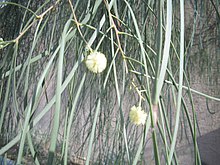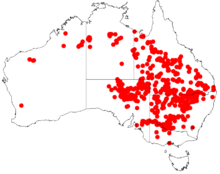bio.wikisort.org - Plant
Acacia stenophylla is a species of Acacia[2] commonly referred to as the shoestring acacia. It is an evergreen tree in the family Fabaceae native to Australia. It is not considered rare or endangered.[3]
| Acacia stenophylla | |
|---|---|
 | |
| Scientific classification | |
| Kingdom: | Plantae |
| Clade: | Tracheophytes |
| Clade: | Angiosperms |
| Clade: | Eudicots |
| Clade: | Rosids |
| Order: | Fabales |
| Family: | Fabaceae |
| Subfamily: | Caesalpinioideae |
| Clade: | Mimosoid clade |
| Genus: | Acacia |
| Species: | A. stenophylla |
| Binomial name | |
| Acacia stenophylla A.Cunn. ex Benth. | |
 | |
| Occurrence data from AVH | |
| Synonyms | |
Description
Acacia stenophylla varies in characteristic and size, from a rounded, multi stemmed shrub to a spreading tree.[4] A. stenophylla grows from 4–20 m (13–66 ft) tall,[4] often stemming into branches at the trunk from about 1 m (3.3 ft).[5] Bark is dark-grey to blackish and rough, branchlets are smooth to sericeous and sometimes angular.[4]
The phyllodes are strap-like, 15–40 cm (5.9–15.7 in) long, 2–10 mm (0.079–0.394 in) wide, straight to slightly curved, slightly rough, free from hair or very finely puberulous, acute to acuminate, apex is often strongly curved.[4] Veins are copious and closely parallel.[6]
Racemes are 3–5-headed, stems 2–15 mm (0.079–0.591 in) long and are slightly rough or with appressed minute hairs.[4] Peduncles are 6–13 mm (0.24–0.51 in) long.[4] Flower heads are creamy-white to pale yellow in colour, spherical and 6–9 mm (0.24–0.35 in) in diameter.[4] Flowers are 5-merous, sepals three-quarters united.[4]
Pods are moniliform, up to 26 cm (10 in) long, 8–12 mm (0.31–0.47 in) wide, woody-leathery textured, smooth except micro-puberulous between seeds.[4] Seeds are longitudinal, elliptic, 7–9 mm (0.28–0.35 in) long, dark brown, lacking aril, funicle enlarged, are folded at the seed apex.[4] Flowering time is often irregular, although mainly occurring in autumn.[4]
Acacia stenophylla is highly salt tolerant and moderately frost and drought tolerant.[7] The average minimum annual rainfall that the tree needs is around 400 mm (16 in) per year.[8]
Distribution
Acacia stenophylla is predominantly distributed in central and eastern Australia.[2] It is also found infrequently in arid regions of Western Australia and towards the southern end of the western coast, although very rarely.[2]
A. stenophylla is found from the Murray River in South Australia and Victoria to western New South Wales, Northern Territory, Queensland, with a small population also occurring in Western Australia.[2]
Latitude - Main occurrence: 23–33°S[2]
Range: 17–36°S [2]
Altitude - Main occurrence: 50–325 m[2]
Range: near sea level to 625 m[2]
Ecology
Climate
Acacia stenophylla is most commonly found in a warm arid climatic zone.[2] Acacia stenophylla tends to grow to a larger size in semi-arid climates which exist in New South Wales and Queensland.[2] The species also expands into the sub-humid zone in Queensland.[2]
Disregarding the species far southern distribution, the mean maximum temperature of the warmest month is 35–38 °C and the mean minimum of the coolest month 4–7 °C.[2] There are, on average, about 110–130 days per year over 32 °C and 15–50 days over 38 °C.[7]
Acacia stenphylla is subject to experiencing 1–20 heavy frosts per year, on average.[2] The species withstands a variable range of rainfall frequency.[2] Rainfall is often amplified by groundwater or periodic flooding.[7]
Physiography and soils
Acacia stenophylla is common throughout the Interior Lowlands physiographic division.[2] It is often present on plains and gentle slopes and is common on the banks of watercourses, river flood plains, and depressions.[2] The soils are predominantly fine-textured alluvials, red sandy clay and grey cracking clays.[2] Soils often have a high pH and may be more saline in the lower horizons.[2]
Vegetation type
Acacia stenophylla occurs in ribbon-like stands along watercourses, often as a part of eucalyptus dominated open-forest, woodland or low woodland.[2] The species can be present in the understorey, often with Acacia salicina and Acacia pendula.[2] It can also occur alongside Eucalyptus populnea and Casuarina cristata, but commonly grows independently alongside watercourses in semi-arid areas.[9]
Utilisation and uses
Acacia stenophylla is rarely utilised by cattle,[10] but it is palatable to sheep.[11] Seeds and pods of Acacia stenophylla were roasted and used by Indigenous Australians as a food source.[12]
The plant is said to contain medicinal alkaloids.[13]
Acacia stenophylla is widely planted as a drought tolerant and decumbent ornamental tree.[2] It is cultivated by plant nurseries, and used in modernist gardens and in public landscapes in the Southwestern United States and California.
Reproduction and dispersal
Acacia stenophylla normally flowers from March to August,[14] although it can flower irregularly throughout the year.[6][15] Seed pods turn woody as they mature from October to December and produce approximately 6–12 viable seeds/g.[7]
Acacia stenophylla seeds germinate prolifically.[16] Proceeding major floods, seedlings can often be present along the flood-line, but only a very small proportion of these persist.[10]
Taxonomy
Acacia stenophylla belongs to the Genus Acacia, comprising 1200 species worldwide.[3] 900 of these species are endemic to Australia.[3]
- Kingdom: Plantae[3]
- Phylum: Charophyta[3]
- Class: Equisetopsida[3]
- Subclass: Magnoliidae[3]
- Superorder: Rosanae[3]
- Order: Fabales[3]
- Family: Fabaceae
- Genus: Acacia[3]
- Species: Acacia stenophylla[17]
Common names
Common names used in Australia include Balkura, Belalie, Black Wattle, Dalby Myall, Dalby Wattle, Dunthy, Eumong, Gooralee, Gurley, Ironwood, Munumula, Native Willow, River Cooba, River Cooba, and River Myall.[1]
Etymology
The specific epithet is derived from the Greek stenos (narrow) and phyllon (leaf) to give “with narrow leaves”.[18]
Gallery
- A. stenophylla – Macquarie Marshes
- A. stenophylla – bark
- A. stenophylla – with seed pods (just south of Moree)
References
- ILDIS LegumeWeb
- Cole, Trevor J. (1981). Planting trees and shrubs. Ottawa: Agriculture Canada. doi:10.5962/bhl.title.59091. ISBN 0-662-10286-X.
- "Acacia stenophylla". www.anbg.gov.au. Retrieved 2020-10-21.
- "Flora of Victoria". vicflora.rbg.vic.gov.au. Retrieved 2020-10-20.
- "Factsheet - stenophylla". worldwidewattle.com. Retrieved 2020-10-20.
- Schmid, Rudolf; Walsh, N.G.; Entwisle, T.J. (May 2000). "Flora of Victoria. Vol. 4. Dicotyledons: Cornaceae to Asteraceae". Taxon. 49 (2): 344. doi:10.2307/1223869. ISSN 0040-0262. JSTOR 1223869.
- Marcar, N.; Crawford, D.; Leppert, P.; Jovanovic, T.; Floyd, R.; Farrow, R. (1995). Trees for Saltland. doi:10.1071/9780643101425. ISBN 978-0-643-10142-5.
- Skeen, Max (May 2009). "Dryland Area Species". Archived from the original on 2006-08-23.
- Pedley, L (1992). "Corrigenda — A further note on Acacia aneura (Mimosoideae : Leguminosae)". Australian Systematic Botany. 5 (6): 767. doi:10.1071/sb9920767c. ISSN 1030-1887.
- Cunningham, G.M.; Mulham, W.E.; Milthorpe, P.L.; Leigh, J.H. (2011). Plants of Western New South Wales. doi:10.1071/9780643104273. ISBN 9780643104273.
- Manifold, C. B. (April 1948). "The Use and Misuse of Shrubs and Trees as Fodder". Geographical Review. 38 (2): 342. doi:10.2307/210871. ISSN 0016-7428. JSTOR 210871.
- Cribb, Philip; Winterringer, G.S.; Sheviak, C.J. (1976). "Wild Orchids of Illinois". Kew Bulletin. 31 (1): 200. doi:10.2307/4109021. ISSN 0075-5974. JSTOR 4109021.
- "Lycaeum". Archived from the original on 2007-09-30. Retrieved 2007-06-18.
- Schmid, Rudolf; Harden, Gwen J. (August 1992). "Flora of New South Wales". Taxon. 41 (3): 627. doi:10.2307/1222862. ISSN 0040-0262. JSTOR 1222862.
- Schomburgk, Richard (1878). Catalogue of the plants under cultivation in the Government Botanic Garden, Adelaide, South Australia. Adelaide: W.C. Cox. doi:10.5962/bhl.title.54333.
- "Lithgow, David Cunningham", Benezit Dictionary of Artists, Oxford University Press, 2011-10-31, doi:10.1093/benz/9780199773787.article.b00110463
- Australia, Atlas of Living. "Species: Acacia stenophylla". bie.ala.org.au. Retrieved 2020-10-21.
- "Plantillustrations.org Epithet: stenophyllus,-a,-um". Archived from the original on December 3, 2018. Retrieved 3 December 2018.
External links
| Wikimedia Commons has media related to Acacia stenophylla. |
- CSIRO Csiro.au: Acacia stenophylla - Australian publication
Другой контент может иметь иную лицензию. Перед использованием материалов сайта WikiSort.org внимательно изучите правила лицензирования конкретных элементов наполнения сайта.
WikiSort.org - проект по пересортировке и дополнению контента Википедии


